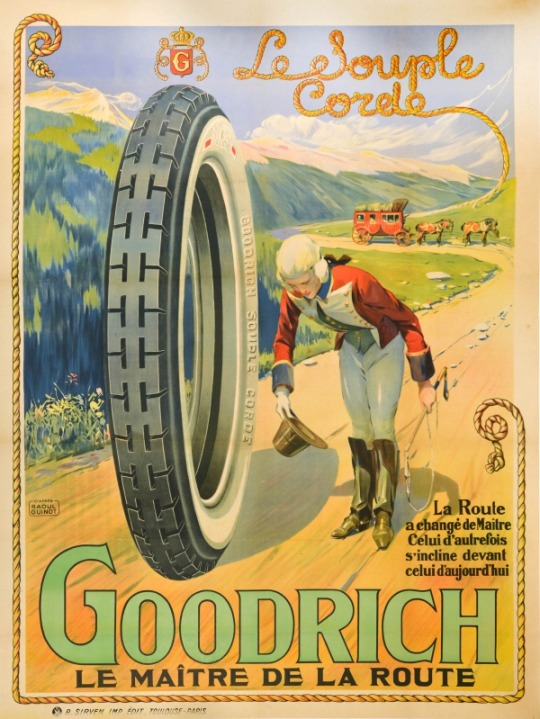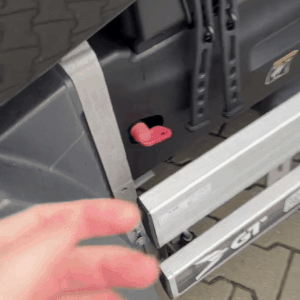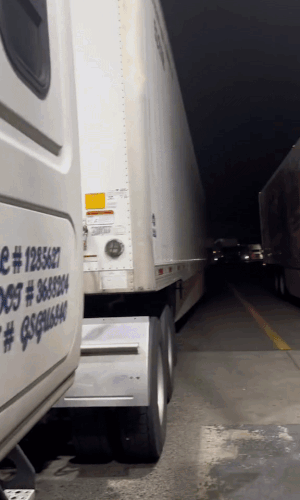#Tyres
Text

Andrew Esiebo. A worker sorts old tyres at a site in the Mile 12 area of Lagos, Nigeria
122 notes
·
View notes
Text

Pirelli Tires
late 1950s
Artist: Lora Lamm
24 notes
·
View notes
Note
Hi Luci! I just wanted to ask if you can explain how the car influences tire warming a little? I’m kind of confused how the set up affects the cars ability to warm them up properly
Okay so there are a lot of factors that affect tyre warming. For the purposes of this post we are going to ignore environmental factors as that is a whole other thing.
There are three main things that impact tyre warming and prep for a lap: the base car, the track specific car setup, the driver's driving on the prep lap
The Base Car
There are two main components about the base of a car that will impact the tyres the most. The downforce and aero load, and the suspension.
Higher downforce will lead to lower tyre temps, as the tyres are being pressed more evenly against the track, leading to more even wear. This was something we have been seeing in the SF-24. Lower downforce conversely will allow for greater top speeds, and leads to less consistent grip, but will allow for tyres to warm more quickly.
Components that affect this are the entire aerodynamic body of the car, but the rear wing, and side pods are especially relevant.
Another element of the base that affects the tyres greatly is the suspension. This is directly connected to the way the tyres behave. And F1 cars use either a push-rod or pull-rod suspension framework. The suspension really impacts the support of the tyres as well as how they move relative to the body of the car.
The Car Setup
There are a lot more elements to track specific setups that can affect the way tyres warm.
Camber: The angle that the tyres are set at for the track. This impacts where the tyres come into contact on the track. This is a big one as it impacts the contact patch of the tyres on the track. This is something that requires the teams to really get this setting right for a specific track, especially in concert with the other elements of the car.
Track specific aero elements: Teams can bring track specific rear and front wings to adjust aero loads. And these will impact the levels of downforce, and thus the tyre warming.
Ride height: this is a big one, as it will impact how close to the ground the car is running, which plays into downforce and top speed capabilities, all of which will play a role in warming or cooling the tyres.
Suspension stiffness: another big one, different tracks require a stiffer setting or more flexibility. This has a direct impact on the tyres as well.
Tyre pressure: this is another big one. Pirelli dictate a range and a required minimum PSI, but teams have to find which pressure setting will work best for the conditions on track. Usually it's lower pressure for qualifying and higher for race day.
These settings all affect the amount of force applied to the tyres when running, and also the specific points on the tyres that force is applied.
The Driver Prep
This is about getting wear on the right parts of the tyres in a short amount of time, and this is done by applying the brakes at certain points, weaving to evenly wear and increase the directional change of tyre in a short amount of time. They also apply the throttle to really put apply some force on the tyres.
A good prep lap will look different on every circuit.
If one of the settings is off there is only so much a driver can do. If the team got the camber settings off then a driver simply cannot get wear correct on the tyre surface.
And for the base, if there is too much or not enough downforce then a driver can only do so much, and the same can be said for track specific setups.
It's all a very fine balance and it's impossible to get right every single time, especially in tricky conditions.
And after all that THEN there is the track conditions to consider(temperature, grip, weather) and your setup has to work with those elements well.
This was a little more than you asked, but these are all variables that work together, it's hard to pull them apart. The base of the car affects the individual setup, and that affects the driver. And the weather affects all of it haha
26 notes
·
View notes
Text

Tyres or Testicles
117 notes
·
View notes
Text

Poster advertising Goodrich tyres (c. 1920). Artwork by Raoul Guinot.
#vintage poster#vintage advertisement#1920s#goodrich#france#Raoul Guinot#french#goodrich tyres#tires#tyres#road
38 notes
·
View notes
Text

Pirelli Tyres
Ducati 916 // Nerves Of Steel
#motorcycle#pirelli#tyres#ad#ducati#916#nerves of steel#sport bike#racing#motorsports#built for speed#ride hard or go home#moto love#lifestyle
51 notes
·
View notes
Text

48 notes
·
View notes
Text









truck stimboard for @enjoyers-enjoyer!
🚚|🚚|🚚
🚚|🚚|🚚
🚚|🚚|🚚
#talos stimboards#stimboard#stim#stim gifs#talos gifs#technology#vehicles#trucks#engines#tires#tyres#?#mechanical#irl hands#city#night#driving#grey#gray#black#brown#green#red#not described#i do not know enough abt engine machines to add image ids. apologies
69 notes
·
View notes
Text

Andrew Esiebo. Car tyres being used as swings. Lagos, Nigeria
23 notes
·
View notes
Text

Nigerian artist Ernest Nkwocha
11 notes
·
View notes
Text

MANY MILES
A tire, aged and abandoned by the road,
Becomes a humble, weathered, seat bestowed.
The rubber, cracked and worn from many miles,
Supports a soul, reflecting on countless trials.
nonnie.bio.link
25 notes
·
View notes
Note
Hi Luci :) Thank you for your technical breakdosns! How do teams decide their tyre strategy? How do you know which tyre compounds to use, which ones among SMS, SHS, etc are more preferable for a particular track?
Hi, thank you!
This is a very complex question. I'll give a brief overview.
The main factors teams consider when planning their tyre strategy is:
- Pirelli selection: Pirelli select the compound range for a track given the conditions of a specific weekend. It is up to the teams to then figure out which of the selected 3 compounds are best.
- The weather: temperature and weather greatly affect which compounds will be most effective. They determine this in free practice(assuming FP sessions are similar in condition to race day)
- The driver's performance on the compounds: another data driven factor is how well the driver is performing on the various compounds. It may be a medium is best, but if a driver is struggling with tyre management then they may have to go with a different pick.
- The cars they are going to try to overtake/undercut: Putting drivers on the right compound to be able to overtake, and time and undercut is important. If a team is hoping to overtake at the beginning they will go for the faster compound, then the more durable one after to keep the place. This is probably the most complex because it involves also trying to predict what the likely competition's strategy will be. And that strategy can change at any moment because a race can change on a dime with track evolution and conditions. A key piece of race strategy is accurately identifying who the main competition to a driver will be, and formulating a strategy to get ahead. Miscalculating this is often what leads with weird or bad strat calls.
- Track evolution: as I stated above, the team can make a pre-race plan, but a race can change quickly, a safety car can come out, more places then expected could be made up etc. This can change the tyre strategy greatly in the moment.
- Holding position or overtaking: tyres to hold position the goal is to keep consistent pace and not push excessively for speed, also to last more laps. Tyres to gain positions would need to be the ones that offer the most speed, which would help a driver have the best chance to position an overtake.
There is more. Tyre strategy is affected by the track conditions, the driver's specific performance, as well as the main competition's performance. It's a logic puzzle that changes in real time based on a whole host of variables.
Hope this helps!
14 notes
·
View notes
Text

Advertisement of the Dunlop pneumatic tyres
French vintage postcard
#carte postale#postkarte#historic#advertisement#postcard#sepia#ansichtskarte#postkaart#tarjeta#pneumatic#tyres#dunlop#briefkaart#ephemera#photography#vintage#french#postal#photo
6 notes
·
View notes

